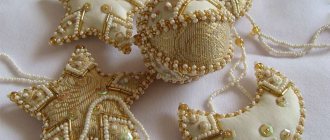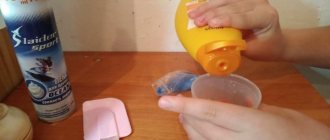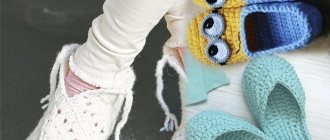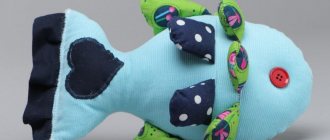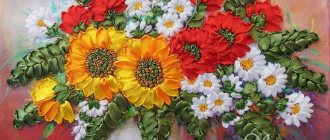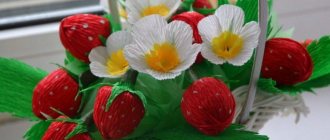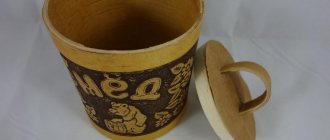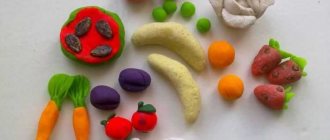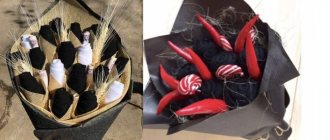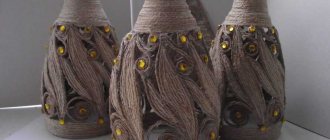We draw water lilies on the water step by step with paints on paper
This drawing will appeal not only to children, but also to adults. We will create a picture of water lilies.
We will paint with gouache. And the first thing you need to do is create a background by applying dark blue paint to the entire sheet of paper.
Then we take the green paint and apply it over the blue. But not with a second layer, but blurred in the lower and upper parts of the picture. The brush should be damp.
Similarly, rub white paint into the upper part of the drawing. Using a damp brush, blur it over the main background.
At the next stage you will need to draw the leaves of the water lilies. To do this, mix three colors: white, green and blue, and with the resulting shade we draw ovals, which will later become leaves.
Now mix white with green and yellow. Using this shade we draw contours along the edges of the leaves.
Mix white and dark blue. Similarly, add a few strokes to the leaves.
The final step is to add green on top of each leaf. but a little.
Then we mix blue with brown and outline each leaf with the resulting shade. At the same time, draw stripes on the water with the same color.
Now we mix the blue color with white and make highlights on the water. There are more of them in the lower part of the picture, and in the upper part there are smaller backgrounds.
The leaves are ready, now you need to draw the water lily flowers.
Drawing water lilies
Mix white with pink, add a little blue. Using the resulting shade we draw the petals of the water lily flower. Apply each petal with a separate stroke.
Then along the edge of each petal we make strokes of white to give the flower volume.
These were the petals that are visible from the inner upper side. Now we draw the outer petals. This is the second row. Add more pink to make the shade more saturated. Apply the next group of petals. After we have drawn these petals, we also draw white along their edges.
Add a little white to this color, which was used to paint the second row of petals. With this lighter shade we draw the third row of petals.
Mix pink, white and blue and draw the last row of petals. Add more blue and shade the edges of the petals.
Using the same color under the flower we draw a highlight or its reflection on the water. Then use blue to separate the flower from this highlight.
Draw an unopened bud next to it in light pink. Use brown paint to add a shadow to the leaves and blur it a little with a damp brush.
Using a light shade, add contours to several petals, stripes on the water, where the shadow of the flower is. These were the finishing touches. As a result, we got this wonderful picture.
What drawing techniques exist
Gouache is a universal paint that is suitable for working in traditional and non-traditional techniques. The main techniques are impasto and glaze. With experience, artists combine them and add their own inventions.
Glaze
The technique involves applying paint alternately in layers. First, apply the first layer, wait for it to dry, and then apply the next one. If you continue working before the previous layer has dried, the colors will blend into a muddy shade. The paint is of medium thickness. To make the smear translucent, add more water. The glazing technique uses up to five tones.
Pastose
The paint is applied in a thick layer. The painting acquires texture and shades thanks to the different directions of the strokes. To prevent the gouache from cracking after drying, PVA glue is added to it.
Mixed
When painting a picture, several types of paints and tools are used - gouache, acrylic, watercolor, oil, pastel, tempera. The techniques are also combined - they shade the background with gouache and paint out the details with acrylic.
How to draw a peacock step by step with a pencil
It turns out that drawing such a bird is easier than it seems. Even a small child can cope with this if he carefully follows the detailed master class. It is necessary to begin the creative process with the preparation of materials. It all depends on the preferences of the painter. It is better to draw the figure with a simple pencil. If suddenly something doesn’t work out, you can always erase it with an eraser. For coloring, you can take whatever you want - pencils, felt-tip pens, crayons, paints.
First step
Let's start by creating the body of the bird. It is small, in the shape of an irregular circle. Then we draw a line - the basis for the neck, and at the tip of it a small circle - the head. Next, we’ll draw the lower border of the bird’s loose tail and casually make two lines at the top - this is its upper border. Let's draw lines for the legs.
Second step
Around the circle we will draw a base for the bottom row of bright feathers. Then we draw the neck and one wing. Let's make the legs clear and draw segments for the second row of feathers. For now we are only making preparatory lines for the bird, so we shouldn’t push too hard with the pencil during the process.
Third step
Now we need to create the eye, beak and cute curls on the head. All that remains is to make lines for a new row of feathers, and you can move on.
Fourth step
In this step you need to draw a couple of small details: segments for the final row of feathers and a couple of curls near the body. The penultimate and last rows of feathers touch the lines that were drawn at the very first stage.
Fifth step
Now it's time to create individual feathers, which are also called "eyes". You can see how other artists or creative people portray it. Let's draw a straight line, then a circle, which will need to be “dressed” with small feathers. Draw a few curls inside the circle.
Sixth step
Remove the extra lines that were used to make it easier to draw and color the miracle bird!
Drawing a peacock step by step
If you can't figure out which shades to use, look at images online.
Another way to draw a peacock
How to draw a peacock with paints
If a child or a novice artist prefers to work with paints, then you can depict a peacock in color. The basis for the work is drawn with a simple pencil. In the process of creating lines, you should not put too much pressure on it so that the segments are not too thick.
In addition to simple tools, you will need paints, watercolor or gouache.
Step by step painting with paints
You will also need to prepare a jar of water, squirrel brushes, preferably thick and thin, a palette and paper for watercolors. Instructions on how to paint a magnificent bird look like this:
- We make two ovals - large and small. The first will be the body, and the second will be the head. We connect these circles with a smooth curved line - this is the neck. Let's draw a large straight line down from the body - it will set the direction of the tail. Below the body we will draw two nearby perpendicular straight lines - this will be a stand for the bird.
- We depict the neck, beak, curls on the head, paws and tail.
- Add eyes, feathers, eyes on the tail, draw a stand.
- Let's take blue paint and paint the body with it, darkening everything around the edges. We use brown and yellow shades for the feathers, and green for the tail. At the last stage, we finish the eyes using blue or dark blue color. Using white paint we create highlights on them. Let's color the paws, head, eyes, beak and stand.
- To draw a peacock for a child, it is worth using examples of ready-made drawings or sketches that can be used to repeat the outlines of the bird. This will simplify and speed up the process.
A selection of master classes on drawing a peacock:
How is it different from watercolor?
On the palette and in appearance, gouache is similar to watercolor. However, its behavior during work is more reminiscent of oil or acrylic. Watercolor works are transparent, they show a transition from light to dark. The name of this paint contains the word “aqua”, that is, water. The main properties are softness and fluidity. Watercolor paintings turn out tender and airy.
1 / 3
Gouache also contains water, but this paint has completely different properties. Gouache works are created by applying opaque brushstrokes to the canvas. Density allows you to apply lighter tones to darker strokes. Using this paint, it is easy to correct errors in the painting; it is quite simple to apply a new stroke over the old one.
1 / 3
Thus, gouache differs from watercolor in the density of application. If watercolor is watery and light, then gouache is rich and dense.
Application options
There are several ways to place paint on drawings:
- Continuous coating – smooth painting of a selected surface. Used to create backgrounds.
- Identification of main components. Similar to a continuous coating, but performed on a fragment with the designation of its boundaries and detailing.
- Emphasizing contours with a similar but slightly distinguishable tone.
- Ipasto is a fine painting of individual elements of 1 or several objects in the design.
- Transition from one tone to another (glaze). This option for applying paint is not suitable for all types of dyes: it is not used when working with dry and oil dyes.
Painting using the glaze technique.
Get creative
Characters
- Quickly sketch a portrait of Frankenstein.
- Choose and draw your favorite superhero.
- Transform your pet into a character.
- Draw a scene from your favorite fairy tale.
- Develop a high-tech robot or car from the future.
- Draw random doodles and then turn those doodles into a character.
- Create your own anime character.
Lettering and calligraphy
- Practice your calligraphy and lettering skills.
- Sketch your favorite quote.
- Turn a word or letter into a drawing.
- Create your own font.
- Create a logo for a fictitious business.
- Create a logo for an existing company, such as Nike.
Doodling
- Create imaginary characters.
- Transform fruit into a person.
- Draw an image from the last dream you remember.
- Recreate your favorite famous painting in your own style.
- Draw a series of five 3D squares and color each one differently.
- Draw a series of basic shapes such as hearts, stars and diamonds.
Abstraction
- Transform your mountain landscape into an abstract fantasy world.
- Make a drawing of your current emotions.
- Ask the person you see to say the first word that comes to mind, and then draw it.
- Create your own print or wallpaper for your desktop.
- Draw a series of objects where each object is not to scale.
- Create your own paisley or mandala pattern.
- Doodle whatever comes to mind without thinking.
Subjects of compositions
Bringing to life a figure about which you know little or is completely uninteresting is quite difficult and the process is unlikely to bring the desired satisfaction. But when the image has a close proximity to a lifestyle or favorite activity, the situation is different.
I want to bring every detail to perfection and bring it closer to reality. When choosing a model from the diagrams proposed in master classes, you should carefully study the list; the first time you may not find a suitable illustration to take up and draw a picture with your own hands.
Don’t be upset, your search will sooner or later yield results; if you find a sketch you like, you can create a unique and impressive composition.
What you need to learn how to draw with a pencil
Not only those paintings that are painted in oils and paints are art. There are many artists who create their masterpieces using a simple pencil. Their creations are truly breathtaking. The pencil as a tool is the most versatile. Almost every person on earth held it in their hands.
The advantages of this type of art:
- Both children and adults enjoy looking at these beautiful drawings;
- There are no limiting criteria regarding a simple pencil. While paints for painting are unlikely to be suitable for children. At a minimum, they will stain their clothes, which will then be difficult to wash;
- This design can be easily copied. Or learn to create with your own hands.
If you first got the idea to draw something with a pencil, then use special master lessons. They can be found on YouTube.com. There are also pictures with step-by-step elements.
When you see in the picture how the artist created it. For example, under the number 1, contours or geometric shapes of the future drawing are drawn. Under the number 2, add colors and so on. With such examples, you will quickly understand the process of creating easy and beautiful drawings and very soon you will be able to take on more complex work.
Mixing gouache
The word “mix” was often mentioned in the workshops. Based on the principles of coloristics, colors are mixed and new ones are obtained. There is no need to buy a bunch of jars of different shades for one design. There is an Itten circle that classifies colors and gives an idea of the correct combination. Harmony is necessary in various creative professions: photographer, artist, designer and others. Colors can be characteristic, uncharacteristic, or harmonious. Opposites are considered harmonious. Characteristic ones are those after one. And those that are next to each other are uncharacteristic. If you place a triangle in the center, you get a three-color harmony, if a square, then a four-color harmony, etc.
To obtain the desired shade, it is important to maintain proportions
The system looks like this:
Itten Circle
Mastering color science doesn't seem like an easy task. People who have not drawn before will only need to look at the circle or find ready-made combinations for their creativity.
Shades are divided into achromatic: white, black, gray and its derivatives, and all the rest are chromatic. Some may not be compatible. But you can still combine them if you know the properties of colors.
Pay attention to these concepts, they will help you in the future:
- Lightness - how close the color is to white;
- Brightness - how close the color is to black;
- Saturation – how faded the color is;
- Hue – colors that belong to the same spectrum.
Knowing these characteristics will help you develop in drawing. Although there are principles, some aspects are still subjective, like all art.
Gouache and oil are similar in consistency, so they mix colors in a similar way. Whitewash is bought in reserve, as it is used up faster.
Basic combinations (parts will be indicated in brackets):
white (9) + blue (1);
yellow (8) + red (2)
yellow (5) + red (5);
white (7) + red (3);
yellow (8) + green (2);
- Grey: white (9) + black (1);
- Lilac: white (9) + purple (1).
This means that a set of colors is enough: white, black, yellow, blue, red. Experiment with gouache first.
You can make a color card. Apply the resulting color and write down how you got it.
How to draw nature with gouache
We will also start creating nature with a pencil sketch. To simplify the task, also attach a piece of paper to the screen and redraw. Now use green to depict the forest in the center and left in the background. While this paint dries a little, apply blue to the sky and the flowing river.
Apply a light green tone to the lower part of the forest. Now let's work with the yellow paint. With this tone, gild the tops of the trees and the lower part of the forest on the left. Cover some trees with dark green paint, as shown in the photo. When it dries, apply a yellow or light green tone to make the painted trees more realistic.
Paint the coastal rocks dark purple, then apply gray and crimson tones here. Add small details to the trees, and the gouache painting, depicted in stages, is ready. You can draw a beautiful landscape by watching the video. A step-by-step lesson will help you create a different picture.
What will you need for drawing?
A journey into the world of fine art is fraught with many interesting surprises. For example, not everyone knows that there are paints:
- Watercolor – diluted with water and dries quickly (within 1-2 minutes);
- Gouache - diluted with water, dry a little longer than watercolor (2-5 minutes), but can be applied in layers;
- Oil-based - diluted with oil or a special solution, dry for a very long time (3-14 days), but can be applied in layers and create expressive reliefs;
- Acrylics are an analogue of oil paints, which are diluted with water and dry quickly (1-2 hours).
There are also paintings, pencil drawings, a style called graphics. For the latter, not only simple, but also colored pencils are used.
But in painting with paints, a pencil is needed only for markings. The main tool here is a brush. You need to select it depending on the paint: watercolor welcomes kolinsky, gouache welcomes synthetics, oil welcomes bristles.
Brushes also vary in size, length and bristle shape. The corresponding variety makes it possible to use one brush for sketching thin branches, another for stamping foliage, and a third for creating a background.
When working with oil, it is also important to use a spatula with a palette knife. It is very convenient to create reliefs and patterns.
In addition to a simple pencil, brushes, palette knife, paints and thinner, the artist will definitely need a palette, an easel and a lot of rags for wiping tools. And, of course, you must not forget to purchase a base - a watercolor sheet or canvas.
Tips for beginners
Before starting work, it is important to learn about the main features of gouache. Painting is not just about dipping a brush into paint, it is a complex process that needs to be understood.
- Brushes. The assortment in stores for artists is huge, there is plenty to choose from. Bristles, synthetic or natural. For gouache it is good to use natural brushes. They are soft but can shed. In addition, they are cheaper than other types. Synthetic ones are also suitable for this type of paint. Bristle – universal. Flat bristles are used for painting using the dry brush technique. Please note that when working, you cannot put too much pressure on the brushes, otherwise they will fluff up and lose their shape. When painting, water is needed only to wash off the color. There is no need to constantly dip it in a glass of water. You need to rinse off thoroughly; if the previous color remains, the shade may change. Important: do not leave brushes in water. Choose several brushes of different shapes and sizes;
- Paper. Gouache can be painted on any surface. The paper chosen is thick, since the paint is heavy. The paper thickness is suitable for pastels. Whatman paper is suitable, which can be cut into pieces;
- Gouache covers everything, so relying on a pencil sketch won't work. Coloring begins from dark elements to light ones. If there was an extra stroke, you can cover the bad spot with another color. Don't overuse this, otherwise the job will be messy. The paint applies differently: it depends on the texture of the paper and the moisture content of the brush. Therefore, you should first try on a separate sheet of paper what each movement will look like. Please note: the paint darkens as it dries;
- Due to the thickness of gouache, you will need a palette, since mixing on paper will not work. As a palette, you can take a board, thick sheet, cardboard or other similar object. It will be more convenient if you buy a palette in a store. If you wash it after each painting session, it will last a long time;
- Depending on your level of proficiency with tools (didn’t draw, painted but little, etc.), a palette knife may be useful. This spatula-shaped tool is used for mixing paints, applying them, or cleaning the palette. It is used in painting with oils and gouache due to their thickness.
Which gouache to choose
Like all coloring materials, gouache comes in different forms:
- For children's creativity. The composition prevents it from crumbling and cracking, the drying speed is higher;
- Acrylic. You can paint on any surface. Does not wash off with water;
- Poster. Denser and brighter than other types;
- Artistic. To work with this paint, use tinted or watercolor paper and uncoated cardboard.
How to draw a simple design on your nails?
You can draw different patterns using different materials. The simplest and most affordable are colored varnishes. But for those who are seriously interested in decorating their nails, it is worth trying other material options.
Gel polish
With gel polish you can create a variety of patterns and effects that will last until you have to repeat the procedure of covering your nails with this material. The technique of painting with gel polish can be different: on an undried coating and on a polymerized one.
The gel polish coating technology is as follows:
- Apply primer (base layer) to the nail prepared with a buffer. If necessary, dry in a lamp.
- Apply colored gel polish. It is at this stage that differences in further actions begin. This layer can be dried and then added with a design. But you can do this before the nail goes to drying. This technique is called “wet”. Only after designing the nail does it dry in a lamp.
- Apply fixative, dry, remove stickiness.
Drawing with gel polish step by step
Acrylic paint
Acrylic is a very convenient material for nail design. It dries quickly, has no odor, and retains pigment well. Apply acrylic paint to a dried surface (varnish, gel polish, shellac, even on a natural nail). To paint your nails, you will need a brush, preferably one with non-natural bristles.
Step-by-step drawing of a flower with acrylic paint
You can also make a French jacket with acrylic and decorate it with an original floral design. The acrylic painting technique is convenient because if the pattern doesn’t work out, you can simply wash it off with water before it dries and start painting again.
In order for the nail painting to last on the nail for a long time, a transparent fixative must be applied over the design.
Using shellac
Just as in the case of gel polish, you can decorate your nails with shellac using the “wet” or “dried” technique. You can use a French manicure as a basis, which is no problem to do on short or long nails. If your nails are still short, then you should not make the French “smile” too wide. When it comes to the design, it should not be too large so as not to visually enlarge the nail plate.
Using pieces of tulle
You can get an unusual manicure if you use simple tulle. Here you can use multi-colored varnishes for the base and pattern. A subtle effect will be achieved if you use a light varnish.
The technique here is simple:
- Paint your nails with a base color (it will act as the color of the final design). Allow to dry thoroughly.
- Place a piece of tulle tightly against the nail. Carefully apply a different color of varnish on top of it. Let the layer dry. Remove the tulle.
- Cover with clear varnish.
Using a piece of tulle with a different pattern, you can get ready-made designs, which is not difficult to do.
Using decorative elements
You can create your perfect manicure without painting on your nails, but simply by correctly using decorative nail material. The color base in this design is necessary in any case, but there are no restrictions on the use of decor.
Rhinestones, stones, and foil can give your nails a special shine that cannot be duplicated by any varnish.
In order for the rhinestones to stick well to the nails, it is better to place them on gel polish that has not yet been dried. After finishing the decoration, you can safely dry it. A layer of topcoat on top is required.
There is also a special foil that applies gel polish without a sticky layer or regular dried varnish. To get a design on your nails, you should glue the foil, iron it on top and carefully remove it. The design that was formed on the foil will appear on the nail.
There is another design option with foil. To do this, purchase special thin pieces of foil (they come in different colors). They are laid out on the nail with an applique, and then secured with a colorless varnish or top coat (for gel polishes). Only with foil you can create unique patterns on your nails.
Using droplets and dots
The dot painting technique will help you create an unusual, but painfully simple manicure. This manicure can be done using varnishes of different colors, as well as gel polishes, shellac, and acrylic paints. The tools you will need are dots. An alternative is toothpicks, a needle, a ballpoint pen tip, etc.
As in previous methods of decoration, you need to apply the main color to the nails, and after it has completely dried, apply the design. The manicure will last longer if you cover the resulting result with a fixative.
Design option for marigold using drip technique
The benefits of drawing for children
Why do all teachers and psychologists recommend starting drawing with children as early as possible? Teaching your child to draw is really important. Creativity is useful for children of early and preschool age for the following reasons:
stimulates fine motor skills and logic; develops speech; helps formulate thoughts and suggestions; improves the function of self-expression; promotes self-affirmation; teaches making non-standard decisions; develops memory and attention; helps improve diligence and perseverance.
The process of drawing for children 2-3 years old and even younger will give a lot of joyful emotions and help diagnose various problems - medical, psychological. Drawing fights complexes, isolation, and self-doubt. This art also lays down the aesthetic perception of the world and reveals the creative inclinations of the child from an early age. Drawing with parents is a reason for additional time together and entertainment.
Watercolor glaze
Step 1
This technique requires improvisation and imagination. Using the example, we will draw an improvised landscape.
First we paint the sky and river with blue paint. We will separate the paint with a small amount of water, this will be a waterfall.
Step 2
Draw the clouds in dark pink and start drawing the mountain in yellow. We will also mark the bottom part of the picture in yellow.
The example uses light and transparent tones so you can see how the layers interact.
Step 3
By mixing cobalt blue and ultramarine blue, we will paint the horizon of the mountain and shade the small yellow slope.
Tip 1: Allow each layer to dry. You can use a hair dryer to speed up this process. Keep it at least 25-30 cm away, turn on the cool setting and set the hair dryer to the lightest air flow. No steam or hot air!
Step 4
To shade and add interesting colors, we use orange. With its help we will create the shores in the foreground and shade the sky.
Tip 2: If you end up with beads of excess paint, rinse and dry your brush as you did in the previous techniques and pick up the beads.
Step 5
Please note that the images show different paint brushes. You can use what you have on hand
Take a dark blue color and use it to highlight the top of the mountain, varying the pressure on the brush and turning it to create an interesting texture.
Step 6
Using the same blue color, let's play with the waterfall by drawing some circles. Sometimes visual clichés become your friends.
Let's rinse the brush and pick up the yellow color, we will use it to add visual details to our shores.
Step 7
After the paint has dried, shade the bubbles in the waterfall with a shade of purple. This way we will make them more interesting.
Step 8
We need to link some elements and add trees. In the example, we used round templates for the crowns, but you can draw as you like.
Step 9
We will use brown color to depict tree trunks. We will also use blue to shade the water and sky a little more. Then, using pink, blue and green, we will paint the grass in the foreground.
Step 10
Use a mixture of pink and red to add the final details. Our trees are now bearing fruit, and several fruits lie under them.
If you look closely, you can see how each layer interacts with each other. A darker shade has more power, but when the colors overlap each other, they create an interesting and beautiful combination.
Master class: painting with gouache
A simple example of how to make a real picture (winter tree) step by step:
- You should start with the background - snow, sky. In the area where there will be a tree, you need to make the sky brighter.
- After drying the background, draw a tree with branches with a pencil. Then draw the contours with paint, drawing well the trunk, brown branches, making them white with snow at the tips. More small branches should be drawn on the main branches.
- Make details. To do this, lighten the small branches and “strengthen” the trunk with dark brown, black gouache. Add gray shadows to the branches.
- To create a brighter picture, you can add pink and blue to the background - like shades of the sky.
To decorate the picture, you can also draw animals, birds, a garland - whatever your imagination suggests. Gouache will quickly become your favorite material for creativity, because working with it is easy and fun!
How to make the lesson interesting?
The drawing process is very useful for children
It develops attention, memory, fine motor skills and imagination. You can draw with your fingers and palms at home, in kindergarten, or use drawing techniques to entertain children during a children's party.
To make the creative activity interesting and bring maximum pleasure and benefit, it is recommended to include elements of the game:
- Make a riddle and ask them to draw the answer with their palm. Example: He gets up at dawn, sings in the yard, has a comb on his head. Who is this? (Cockerel).
- Read a fairy tale to the children, and then invite them to portray their favorite character. Example: “The Fox and the Goat”, “How the Fox and the Sheep Punished the Wolf”, “Teremok”.
- Organize group drawing. Children can draw the sun or the underwater kingdom together. To do this, everyone makes a ray imprint or a fish imprint with a pen.
- Conduct an educational lesson on the topic “winter”, “autumn” or another with games, riddles, round dance and songs. At the end of the lesson, consolidate the acquired knowledge by drawing a thematic picture with your palm. For example, a winter forest, a snowflake or an autumn tree.
Unconventional drawing techniques
To make the paintings look unconventional and reflect the individual vision of the author, unusual methods of applying paint are used. In children's creativity, the use of non-traditional and mixed techniques helps to learn to think outside the box and think through a work plan.
Monotype
The painting, made using the monotype technique, resembles a printed drawing. How to get a fingerprint:
- draw an image on one half of the sheet;
- fold the sheet in half and press so that fresh paint is imprinted on the clean half;
- unfold the paper.
On the second half of the sheet there will be an imprint of the image, similar to a printed illustration. The peculiarity of monotype is that each picture is unique, and there are no two identical prints. One or more colors are used in the drawing. With the help of a print, main or background objects are made. Details are added to the printed image using regular strokes.
Using the monotype technique, symmetrical color spots were made on cards of the Rorschach psychological association test.
Diatypia
The technique also refers to the printing method of image:
- Apply a layer of paint to a smooth, dense surface with a roller;
- place a sheet of thin paper on top of the fresh paint;
- draw a picture with a pencil;
- remove the thin sheet.
The drawing will be printed on thick and thin paper, and you will get two pictures with the same plot. Lines can be drawn with sticks of different thicknesses, and several colors can be applied to a dense base. The image on a colored background looks three-dimensional and non-standard. Instead of a roller, use a cotton cloth. To more accurately position objects, the white sheet is replaced with translucent tracing paper.
Blotography
The technique involves applying blots and splashes of paint to the canvas.
How to do it:
- dip the brush into the paint;
- wait until a drop drips onto the paper, or randomly spray gouache on the surface with your hand;
- blow on convex large drops from above or through a cocktail straw.
First, you will get abstract drawings from blots. To give them the shape of animals and plants, alternate large and small splashes. The paint is also smeared with paper placed on top.
See also
Design and dimensions of paint booths for cars, their types and operating principles
Using the blotography technique, interesting sea creatures are obtained: anemones, corals, jellyfish, mollusks. With the help of blots it is easy to depict water, rain, a drop in slow motion. Splashes can be placed on a monochromatic dried background or secondary objects can be painted with regular strokes or using other techniques.
Happening
The technique does not use brushes, but rather applies the paint by hand. There are two types of happenings:
- applying color spots with palms and fists;
- drawing and coloring objects with your fingertips.
The contact method of drawing develops fine motor skills in children. For finger painting, a special gouache is produced based on natural pigments and adhesives. They are safe for the skin and wash off easily.
Easy drawings about night in gouache on paper for beginning artists
In this section we will try to draw a night landscape. For this we use gouache. At the first stage, take dark blue paint and paint the entire sheet with it.
It is advisable to paint in one direction, for example horizontally from right to left. After the background has been applied, take white paint and draw a straight line just above the middle of the sheet. This will be the horizon. Then dip the brush in water and blur the white stripe across the entire upper half of the sheet.
We get a color change from dark blue to light blue.
The next step is to draw the moon. Select an area for it in the upper part of the picture and draw a circle in white. Then we blur it on the sides, as we did in the previous step. Just blur it in a circle. As a result we get:
We've drawn the moon, now we're making stars. There are several ways to go about this. You can take a very thin brush, dip it in white paint and put small dots on the sky. Or you can just spray it with a brush. You'll get a lot of star spray. With a thin brush, you can paint several stars with brighter white paint, designating them into constellations. Then we draw a circle of the moon with white paint.
Examples of images for sketching, tips for beginners
Tips for beginning artists:
- It is not recommended to apply gouache to paper in a thick layer. After drying, the paint may crack and crumble.
- Gouache is quite thick, so brushes need to be washed thoroughly. You can use a soap solution and a special plastic board with embossed edges.
- You need to mix the paint and make test strokes on the palette, otherwise you can ruin the drawing.
- Despite the high density of gouache, the pencil sketch should be thin and light. Furrows and dark lines pressed into the paper will be noticeable even after coloring, making the drawing appear dirty.
- In order not to go beyond the boundaries of the contours, they should be painted moving from the edge to the center.
- All lines must be broken. This way the drawing will look more natural.
- When drying, the gouache brightens by 2-3 tones. This should be taken into account when choosing shades.
- Drawings made with gouache should be stored flattened. They cannot be folded or rolled into tubes. The paint may crack and peel.
Learning to paint different types of flowers with gouache is easy. Beginning artists will be helped by step-by-step descriptions and photographs of finished works that can be used for sketching.
